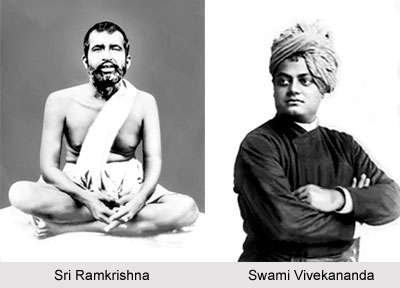 Political repression, superstitions and narrowness in the social life of Indian society made the socio-religious scenario extremely anarchic. Rigidity in Hindu society led towards caste system and untouchability, which became all the more prominent in society. The didactic rationalism of Brahmo Samaj mostly appealed to the intellectual cult of the elite class in India. But common people found solace in the cults of Bhakti and yoga. The Ramkrishna Mission movement was mainly organised on the basic and the ancient principles, blended with Western Renaissance. Ramkrishna Mission was conceived and founded by Swami Vivekananda in 1897, eleven years after the death of Sri Ramkrishna.
Political repression, superstitions and narrowness in the social life of Indian society made the socio-religious scenario extremely anarchic. Rigidity in Hindu society led towards caste system and untouchability, which became all the more prominent in society. The didactic rationalism of Brahmo Samaj mostly appealed to the intellectual cult of the elite class in India. But common people found solace in the cults of Bhakti and yoga. The Ramkrishna Mission movement was mainly organised on the basic and the ancient principles, blended with Western Renaissance. Ramkrishna Mission was conceived and founded by Swami Vivekananda in 1897, eleven years after the death of Sri Ramkrishna.
Sri Ramkrishna was the central source of all power in Ramakrishna Movement. He had come with a worldwide mission and all the activities are to be regarded as manifestations of his divine mission. He is the focal point upon which the lives of men and women and the functions of various institutions of Ramakrishna Movement converge. Sri Ramkrishna was a poor priest in the Kali Temple of Dakshineswar. His ideals were deeply rooted in Indian thought and culture, although he recognised the Truth in all religions. He considered and emphasised that Krishna, Hari, Rama, Christ, Allah are different names of the same God. Unlike the Arya Samaj, Ramakrishna Mission recognises the utility and value of idol worship in developing spiritual fervour and worship of the eternal Omnipotent God. However, Ramkrishna laid particular emphasis on this essential spirit. He stood for selfless devotion towards Gods and not on symbols or rituals.
The Ramakrishna Movement consists of four streams. Ramkrishna Mission and Ramkrishna Math together form the main stream. Swami Vivekananda had started these twin institutions with the help of other great disciples of Sri Ramkrishna. Selfless devotion towards God with a view to ultimate absorption within Him, was the sole motto of Ramkrishna Mission Movement. Spirituality and compassion for the suffering humanity was the ideal of Ramkrishna Mission Movement. The original inspiration and power were maintained through an unbroken succession of spiritual teachers and centralised administration.
It was left to Swami Vivekananda to render the interpretation of teachings of Ramakrishna and deliver them to the modern man. Vivekananda emerged as the preacher of neo-Hinduism. He had attended the Parliament of Religion held in Chicago in 1893 and made an immense impression by his interpretations. The keynote of the interpretation of Swami Vivekananda was the balance between spiritualism and materialism. He had envisaged a new culture for the whole world, where materialism of the West and spiritualism of the East would be blended into a new harmony to produce happiness for mankind.
The champion of Ramkrishna movement, Swami Vivekananda, decried untouchability and caste system. He strongly condemned the practice of untouchability prevalent in the rigid Hindu society. He regretted that Hinduism had become confined within narrowness. He strongly criticised caste system and oppression of the poor by the rich. The dictum of Ramakrishna Mission Movement was that God and humanity are the supreme. Therefore, insult to humanity is a direct insult to god. Thus, Swami Vivekananda emphasised the fundamental postulate of his master, Sri Ramkrishna Paramhansha that the best worship of God is through the service of Humanity. In this way the Ramkrishna mission movement had induced a new social purpose into Hinduism.
From the very beginning, the Ramkrishna Mission Movement aimed for reformation of the entire society from its root. It ran a number of charitable dispensaries and hospitals, offered help to the poor and the afflicted during natural calamities. However the Ramkrishna Mission movements did not have any political message. In a whole, Ramkrishna Mission movement aimed for a new generation, infused with a sense of pride in India`s past, a new faith in India`s culture and a rare sense of self-confidence in India`s future.






































